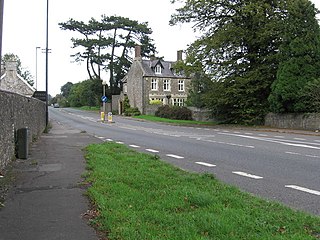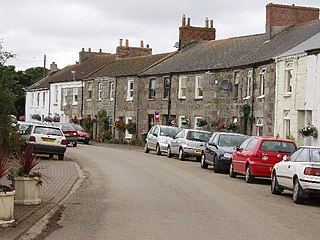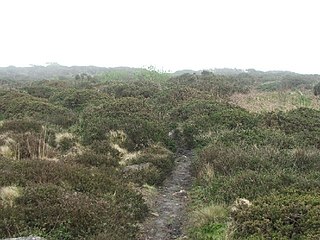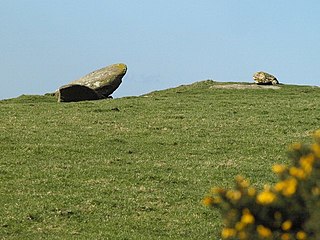Related Research Articles

Chysauster Ancient Village is a late Iron Age and Romano-British village of courtyard houses in Cornwall, United Kingdom, which is currently in the care of English Heritage. The village included eight to ten houses, each with its own internal courtyard. To the south east is the remains of a fogou, an underground structure of uncertain function.

Llantwit Major is a town and community in Wales on the Bristol Channel coast. It is one of four towns in the Vale of Glamorgan, with the third largest population after Barry and Penarth, and ahead of Cowbridge. It is 4+1⁄2 miles (7.2 km) from Cowbridge, 9 miles (14 km) from Bridgend, 10 miles (16 km) from Barry, and 15 miles (24 km) from Cardiff. It had a population of 9,486 in 2011.

Rudgeway is a village in South Gloucestershire in south west England, located between Alveston and Almondsbury on the A38 trunk road. It lies west of Earthcott, Latteridge, Iron Acton and Yate on the B4059 road.

Constantine is a village and civil parish in Cornwall, England, United Kingdom. It is situated approximately five miles (8 km) west-southwest of Falmouth. The electoral ward also bears the same name but includes Budock Water and the surrounding area. At the 2011 census, the population of the ward was 4,709 and the population of the civil parish was 1,789. The parish of Constantine is bounded by the parishes of Mabe, Mawnan, Gweek, Wendron and the north bank of the Helford River.

Manaccan is a civil parish and village on the Lizard peninsula in south Cornwall, United Kingdom. The village is about five miles (8 km) south-southwest of Falmouth.

Grade–Ruan is a civil parish on the Lizard peninsula in Cornwall, England, United Kingdom, approximately ten miles (16 km) south of Falmouth.

Mawgan-in-Meneage is a civil parish in Cornwall, United Kingdom. It is situated in the Meneage district of The Lizard peninsula south of Helston in the former administrative district of Kerrier. The parish population at the 2011 census was 1437.

Halliggye Fogou is one of many fogous in Cornwall, England, United Kingdom.

Marholm is a village and civil parish in the Peterborough district, in the ceremonial county of Cambridgeshire, England. West of Peterborough and 1 mile from the seat of the Fitzwilliam family at Milton Hall. The parish covers some 1,400 acres, with the village positioned roughly in the centre. For electoral purposes it forms part of Northborough ward in North West Cambridgeshire constituency.

St Hilary is a village in the Vale of Glamorgan, Wales. It is located just south of the A48, about a mile southeast of the market town of Cowbridge. The village has a population of about 260, in approximately 80 houses. Notable landmarks in the vicinity include The Bush Inn, the Church of St Hilary, the Old Beaupre Castle, New Beaupre, Coed Hills and St. Hilary mast.

Shalden is a village and civil parish in the East Hampshire district of Hampshire, England. It is 2.3 miles (3.7 km) northwest of Alton and 1.9 miles (3.1 km) northeast of Bentworth, just off the A339 road. The parish covers an area of 1,536 acres (622 ha) and has an average elevation of 600 feet (180 m) above sea level. The nearest railway station is Alton, 2.5 miles (4.0 km) southeast of the village. According to the 2011 census, it had a population of 435.

Bodgate is a farmstead in east Cornwall, England, United Kingdom. It is situated in North Petherwin civil parish about 0.5 miles (0.80 km) south of North Petherwin village, five miles (8 km) north-west of Launceston. The parish was transferred from Devon to Cornwall in 1966.

Gwinear is a small village in west Cornwall, England, UK. It is about two miles (3 km) east of Hayle and overlooks the Angarrack valley. It is in the civil parish of Gwinear-Gwithian.

Caer Bran Hill Fort is an archaeological site near Sancreed and Carn Euny Iron Age village, on the Penwith peninsula in Cornwall.

Hendraburnick is a farmstead near Davidstow, Cornwall, England. On Hendraburnick Down is the source of the River Camel.

Relubbus is a hamlet in the parish of St Hilary, west Cornwall, England. It is on the B3280 road between Townshend and Goldsithney; the River Hayle runs through Relubbus.

Rosenannon is a hamlet in Cornwall, England, United Kingdom. It is within the civil parish of St Wenn, 4 miles (6.4 km) south-west of the town of Wadebridge.

Stowe House in the parish of Kilkhampton in Cornwall, England, UK, was a mansion built in 1679 by John Grenville, 1st Earl of Bath (1628–1701) and demolished in 1739. The Grenville family were for many centuries lords of the manor of Kilkhampton, which they held from the feudal barony of Gloucester, as they did their other principal seat of nearby Bideford in Devon. It is possible that the family's original residence at Kilkhampton was Kilkhampton Castle, of which only the groundworks survive, unusual in that it had a motte with two baileys.
Presented below is an alphabetical index of articles related to Cornwall:

Arrallas was a manorial settlement recorded in the Domesday book, when in 1086 it had seven households and three ploughlands. It is located in the parish of St Enoder in Cornwall, England. Its name derives from the Cornish language words arghans and lys meaning "silver court", with the lys likely denoting a site of royal importance.
References
- ↑ "View: Cornwall LXIX.SW (includes: St Erth; St Hilary.) - Ordnance Survey Six-inch England and Wales, 1842-1952". maps.nls.uk. Retrieved 18 November 2017.
- ↑ "North Treveneague Farmhouse A Grade II Listed Building in St. Hilary, Cornwall". Britishl Listed Buildings. Retrieved 20 November 2017.
- ↑ "Farm Buildings North of Treveneague Farmhouse A Grade II Listed Building in St. Hilary, Cornwall". Britishl Listed Buildings. Retrieved 20 November 2017.
- ↑ Cornwall, Royal Institution of (April 1868). "Chronological Memoranda". Journal of the Royal Institution of Cornwall (9): 69. Retrieved 20 November 2017.
Coordinates: 50°08′33″N5°25′59″W / 50.14250°N 5.43306°W